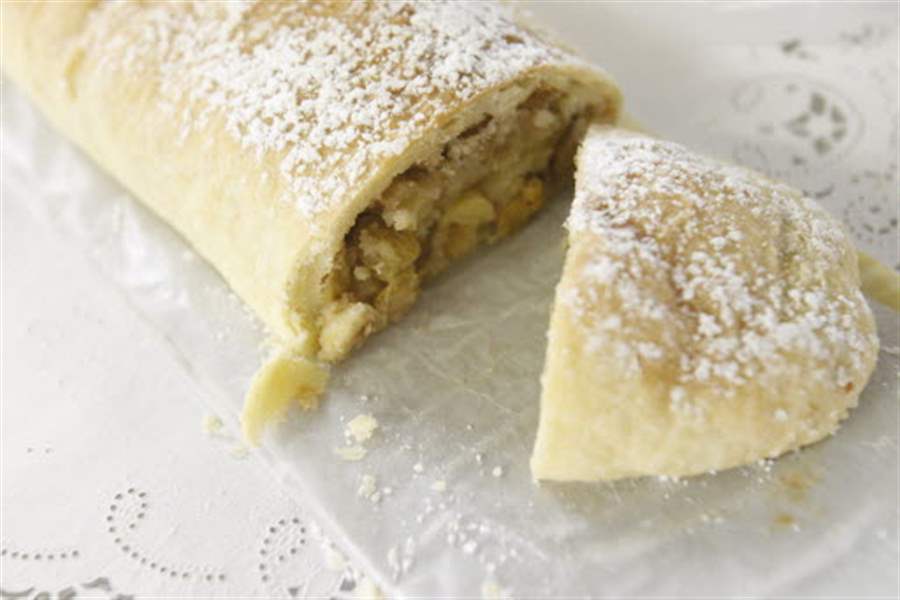
Toledo area festival's contest entries are winners
9/8/2009
Lieselotte Sielicki's Apple Strudel won third place.
Authentic German recipes are an art too rarely seen. There are few German restaurants in our area, much less an Old World-style German bakery.
But this year Diane Schmidt spearheaded the effort to feature authentic German baking recipes at the German-American Festival's German Baking Contest on Aug. 29 in Oregon.
Of the 10 entries, there was one strudel, one torte, one bread pudding, five kuchens, a streusel pie, and a German-style cake judged at the Sidewalk Cafe at Oak Shade Grove to the tune of German music and the hustle and bustle of the crowd.

First place went to Carolyn Schimmel of Huron for Plum Kuchen. Second place was awarded to Rosie Whitt of Oregon for Philadelphia Torte, and third place went to Lieselotte Sielicki of Perrysburg for Apple Strudel.
"This contest encouraged people to bake German recipes," said Ms. Schmidt, chairman of the contest and an avid fan of the Food Network. "That's where I got the idea from, to bring excitement to the festival."

Lieselotte Sielicki's Apple Strudel won third place.
The event was so successful that she is already planning for next year. "Several ladies said afterward to me that they would like bake something for next year."
There's plenty to chose from in authentic German baked goods.
Kuchen (KOO-kuhn) is among the most inventive of German baking, according to A Baker's Odyssey by Greg Patent (Wiley, $34.95). Likened to a coffee cake, it is often a yeast dough containing butter and eggs and topped with fresh in-season fruits sprinkled with sugar and baked. In some cases a cooked custard is spread over the fruit before baking.

The entries in a German Baking Contest held during this year's German-American Festival at Oak Shade Grove in Oregon.
Some of the doughs are almost cake-like and the fruit is stirred in. Plums are a popular fruit to use, and so are apricots, cherries, and apples.
Carolyn Schimmel's Plum Kuchen, a family recipe, had a crust made with baking powder, and the plums were neatly arranged over the rectangular pastry. The heavy cream-egg yolk mixture was spread over the fruit before baking.
For the kuchens in this contest, some had arranged fruit (fruits included plums and peaches) and others had more of a cake-like dough with the fruit interspersed.
Tortes are a rich cake made with little or no flour; instead it has eggs, sugar, and other ingredients and is multilayered with buttercream and fruit.
The second-place winner seemed to me to be a contemporary German torte.
Rosie Whitt, who came to the United States from Germany 47 years ago, brought the recipe for Philadelphia Torte back from Germany 10 years ago. "I had the recipe translated," she said. "My cousin used Philadelphia Cream Cheese for it, which they can buy there," she said.
It's an ambitious recipe that takes two to three days to make. On day one, bake the cake; on day two, prepare the filling and let it sit at least six hours, but overnight is better, and on day three, serve the dessert.
Among the special German ingredients is the vanilla sugar packet sold at The Andersons and Kilgus Market. Brands include Ruf and Oetker.
To decorate the dessert, she used shaved chocolate and chocolate designs she brought back from Germany. She's used mandarin oranges as a topping, along with white and dark chocolate. She made whipped cream rossettes to decorate the top, too.
Classic apple strudel has layers of paper-thin buttery pastry rolled around a generous amount of apples, cinnamon, raisins and walnuts, and it is baked until it is crisp and golden brown. It is popular in Germany, Austria, and much of Central Europe. Paper-thin strudel can resemble phyllo.
The fillings for strudel can be savory or sweet.
Lieselotte Sielicki's Apple Strudel won third place. It's a recipe given to her by a Toledo friend 20 years ago. Mrs. Sielicki came to the United States from Germany in 1952 and in 1953 to Toledo. For many years she was the chairman of the Sidewalk Cafe for the German Festival. But this year you stepped down from that position and concentrated on baking 15 German cakes and making 576 Buckeye candies to sell at the Sidewalk Cafe as well as the strudel for the competition.
She makes the strudel dough from scratch. "You can't just eat one piece of strudel," said Mrs. Sielicki, who sprinkles just a little cinnamon over the apple filling because she told me that cinnamon was never used much in Germany as she remembers.
I was one of the judges of the contest along with Mayor Marge Brown of Oregon, and Chef Ron Banas of Oregon Career and Tech Center. I found the 10 recipes representative of German baking, but, the contest made me realize how few cookbooks there are on German cooking.
Thus, these authentic recipes need to be preserved through contests like this and by passing the art of German baking on to the next generation. Whether it's German cookies or kuchens, strudels or tortes or even a stollen, German baking is always delicious.
Kathie Smith is The Blade's food editor.
Contact her at:
food@theblade.com
or 419-724-6155.